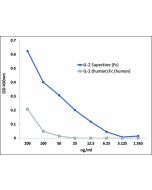Cookie Policy: This site uses cookies to improve your experience. You can find out more about our use of cookies in our Privacy Policy. By continuing to browse this site you agree to our use of cookies.
Chimerigen
IL-2 (C145S Mutant) (human) (rec.) (His)

| Product Details | |
|---|---|
| Synonyms | Interleukin-2; Aldesleukin |
| Product Type | Protein |
| Properties | |
| Source/Host | HEK 293 cells |
| Sequence | Human IL-2 (aa 21-153) (mutation C145S) is fused at the C-terminus to a His-tag. |
| Crossreactivity |
Human Mouse |
| Biological Activity | Measured by its ability to stimulate the proliferation of mouse CTLL-2 cells. The ED50 for this effect is typically 0.1ng/mL, corresponding to a specific activity of 1x 107 units/mg. |
| MW | ~19kDa (SDS-PAGE) |
| Purity | ≥95% (SDS-PAGE) |
| Endotoxin Content | <0.01EU/μg protein (LAL test; Lonza). |
| Reconstitution |
Reconstitute 10µg vial with 100 µl sterile water to a concentration of 0.1mg/ml. Reconstitute 50µg vial with 100 µl sterile water to a concentration of 0.5mg/ml. Add 1X PBS to the desired protein concentration. |
| Formulation | Lyophilized from 0.2μm-filtered solution in PBS. |
| Other Product Data | NCBI reference NP_000577.2: IL-2 (human) |
| Declaration | Manufactured by Chimerigen. |
| Shipping and Handling | |
| Shipping | BLUE ICE |
| Short Term Storage | +4°C |
| Long Term Storage | -20°C |
| Handling Advice |
Avoid freeze/thaw cycles. Centrifuge lyophilized vial before opening and reconstitution. PBS containing at least 0.1% BSA should be used for further dilutions. |
| Use/Stability |
Stable for at least 1 year after receipt when stored at -20°C. Working aliquots are stable for up to 3 months when stored at -20°C. |
| Documents | |
| Product Specification Sheet | |
| Datasheet |
 Download PDF Download PDF |
Interleukin-2 (IL-2) is a 133 amino acid glycoprotein with one intramolecular disulfide bond and variable glycosylation. It is secreted by activated T cells and induces proliferation and maturation of activated T cells, natural killer cells, and lymphokine activated killer cells. IL-2 also stimulates proliferation of antibody-producing B cells, activates neutrophils, and induces mononuclear cells to secrete IFN-γ and TNF-α and -β. Moreover, studies have shown that IL-2 is required for activation-induced apoptosis, an important hemeostatic mechanism in the immune system, which is involved in the maintenance of peripheral tolerance to self-antigens. The modified IL-2 protein containing a substitution at position C145S retains full biological activity, suggesting that the cysteine at this position is not involved in a disulfide bond and that a free sulfhydryl group at that position is not necessary for receptor binding. Additionally, the C145S mutation insertion avoids non-specific disulfides and improves the physical properties of the protein.







